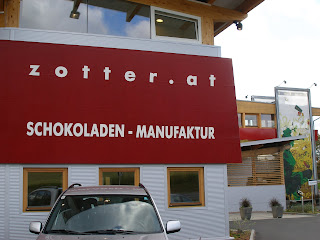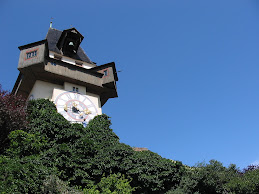 Ever since I was little, I've loved "Willy Wonka and the Chocolate Factory". The old version with Gene Wilder was a movie I never tired of, and I could sing every last song (including the many varieties of oompah-loompah songs) by heart. Whenever I watched the film, I had fantasies of being able to visit such an intriguing and enchanting Candyland, and I envied the child actors that actually got to do so! I was always torn between wanting to be Violet and Veruca--Violet got to roll around in a big blueberry suit (which looked like a lot of fun!), but Veruca definitely got the best song ("I Want It Now"). It was a tough call.
Ever since I was little, I've loved "Willy Wonka and the Chocolate Factory". The old version with Gene Wilder was a movie I never tired of, and I could sing every last song (including the many varieties of oompah-loompah songs) by heart. Whenever I watched the film, I had fantasies of being able to visit such an intriguing and enchanting Candyland, and I envied the child actors that actually got to do so! I was always torn between wanting to be Violet and Veruca--Violet got to roll around in a big blueberry suit (which looked like a lot of fun!), but Veruca definitely got the best song ("I Want It Now"). It was a tough call.Last Friday I got as close as I'll ever be to living out these fantasies. The Zotter Chocolate Factory, located in southeast Styria in the town of Riegersburg, is just a quick car ride away from the school where I'm teaching. My amazingly perceptive supervising teacher had the insight to realize that an excursion to the chocolate factory was just what we'd need on a Friday afternoon. So last Friday after the last class was over, we drove on out to Riegersburg with great eagerness and eyes that were most certainly bigger than our stomachs. On the ride up, my eyes were glued to the window and the breathtaking Austrian countryside. I am contantly awed by the landscape here, and it became clear to me during the trip up to the chocolate factory that I'd be quite content with life if all I had was a car and enough gas to aimlessly drive all through Austria.
As we drove up the hill into Riegersburg, the Riegersburg castle rose to greet us. Set up upon a cliff, it really is quite majestic and intimidating (in a picturesque sort of way); owned by the family Liechtenstein--as in the country of Liechtenstein--this castle seems to fit the nobility to which it belongs.We arrived at the Zotter Chocolate Factory to find an unimposing but modern facade. Our 90 minute tour was about to begin, so I tore myself (and my camera) away from the countryside and the funny woolly cows to head inside. We were greated by the tour guide as we entered, and we gave our names at the desk--reservations are necessary here so that they're not overwhelmed by hoardes of Willy Wonka fans like myself. First off, we were given a spoon--the kind like you'd get for soup at a Chinese restaurant--and told to enter the Chocolate Theater. Puzzling over the funky spoons in our hands, we entered the theater and began the tour with a short video of South American farmers explaining their work and their lives as cocoa bean harvesters. The Zotter Chocolate Factory produces entirely organic and eco-friendly chocolates, and they are also heavily involved with environmental preservation and saving the animals. Thus, we learned about both bean harvesting and standards, and also about what a fine and conscientious man Mr. Zotter is to work for. It was rather amusing to see the Spanish subtitled into German though...I mean, it totally makes sense, but my mind was swimming with all the languages!
After the film, we were led into the first portion of the factory where the beans are cleaned, refined, and made into a cocoa-y sludge. As the tour guide explained the process, I stared down in wonder at the real-life oompah loompahs as they scurried from big chocolate machine to big chocolate machine. Rather than orange-faced midgets with green hair and cute little overalls, my real-life oompah loompahs were dressed in immaculate white (...which, for me anyway, would be such a disastrous color to wear around liquid chocolate...) and tended to shiny white machines with shiny white labels on shiny white floors. I tore myself away from this little daydream just in time to hear the tour guide inviting us to sample some cocoa from the chocolate fountain in the middle of the room. It was a beautiful chocolate fountain, with a rich and velvetly-looking cascade of chocolate coming out the top. As I'd been daydreaming about Oompah Loompah Land, I missed the part where he told us that this was 100% cocoa--that is, 100% ground up cocoa bean mush without any other additives. My heaping spoonful betrayed my inattention, and I didn't catch on when the other tour-goers gave my spoon a skeptical glance. Instead, I ignorantly indulged in a heaping spoonful. My reaction was immediate--my face contorted from the bitterness, and my mouth puckered as my tongue suddenly assumed the sensation that it was made of cardboard. And of course, of course, this was captured on film by my amused companions!
From this section we were led to a new room of chocolate fountains. Wary as one of Pavlov's dogs, I approached these fountains with a touch more caution. This room demonstrated the different types of chocolate--from 10% cocoa on up to 100%. After a brief explanation of the role and strength of cocoa in the chocolate manufacturing process, we were once again invited to use our spoons and sample from the fountains. Having wised up, this time I began at the end of the line--with the 100% cocoa chocolate--and worked my way down to the very sweet 10% option. I found that with 80%, the chocolate became tolerable, but with 70% it was first enjoyable.
From there, we got to see how all of the chocolate bars are cut by hand and turned into the finished product--all by hand! Having seen this process through from beginning to end, we were then taken through yet a few more sections where we were invited to sample the chocolates. In one room, we were invited to try the Trink-Schokolade, or Drink-Chocolate. Essentially, this Trink-Schokolade is a special type of chocolate melted in warm milk to make a sort of specialty hot chocolate. Overlooking the beautiful Austrian countryside, assorted shots of Trink-Schokolade came out on a conveyor belt and circled the rooms on a little pulley system--totally something out of "Willy Wonka and the Chocolate Factory"! In the next room we were invited to sample an assortment of chocolate-covered things from rotating copper basins. All sorts of chocolate-covered things. There was your usual chocolate-covered cashew or blueberry or ginger root, but there were some truly odd flavors as well. By far the most bizarre (and alarming!) flavor was Zimt-Grammeln, or Cinnamon-and-unmelted-residue-left-after-animal-fat-has-been-rendered. ...Did you get that??
Yeah, it was chocolate-covered, cinnamon-flavored dried-up animal fat!! ...Those Austrians!Finally, our tour ended with the chocolate bar sampling. As if we hadn't had enough chocolate already, we came out near the factory store, where a conveyor belt brought samples of different chocolate bars and we could take and sample as we pleased. It probably took about 10 minutes for all of the different flavors to travel by, and since it was dangerously close to the chocolate factory store, I was unable to get out of there without buying a few bars myself. A sucker to the fantastic marketing ploys, I didn't feel too guilty about my purchases since the flavors were both insanely unique and astonishingly good. Among the most interesting flavors available were: Pinapple and Pepper, Banana Curry, Pepper and Mint, Rose and Basil, Tofu and Sake, and India Masala. And the three types that I came out with were Pinapple Cashew (there are no words to describe the bliss that is Pinapple Cashew chocolate), Lemon Polenta (also an indescribable and tasty treat), and Hot Chicken Ensemble (I was mostly taken with the name of this one, but it's made with egg liquer, yummm).
Surprisingly, I wasn't sick to my stomach. I did a good job of pacing myself and didn't reach the point where I thought I might turn into Violet Beauregarde and explode. And that, I believe, signals the success of Rebecca and the Chocolate Factory. The Zotter Chocolate Factory is definitely going high on my list of places to take any visitors to Austria--and to see this trip in pictures, check out my Flickr link to the right!













